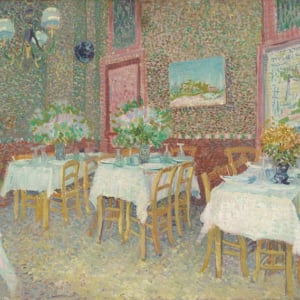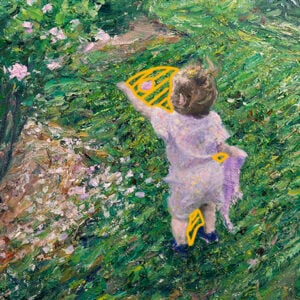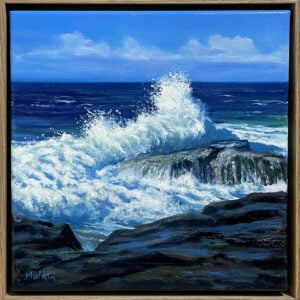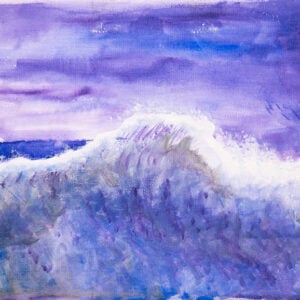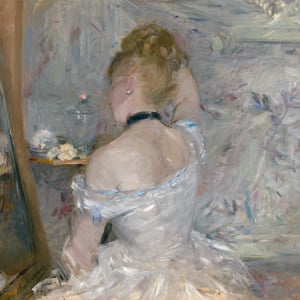This is a detailed guide on gouache painting. I’ll cover:
- What is Gouache?
- Brief History of Gouache
- Famous Gouache Artists
- Why Gouache?
- What Do You Need to Paint With Gouache?
- General Tips
- Additional Resources
- Thanks for Reading!
- Want to Learn More?
- Thanks for Reading!
What is Gouache?
Gouache (pronounced ‘gwash’) is water-soluble paint that has a matte finish. It is similar to watercolor but is opaque instead of translucent.
Gouache paint consists of color pigments bound in gum arabic or dextrin. White pigment or chalk-like material is added to the mixture to make the paint opaque. Sometimes you’ll see gouache referred to as “opaque watercolor.”
Gouache combines the best qualities of other painting mediums. Like watercolor, it dries quickly and can be re-worked and adjusted after drying. But like oil and acrylic, it is more opaque and produces strong and vivid color. It is typically used on paper, rather than canvas or wood.
Brief History of Gouache
The term gouache originated in France in the eighteenth century and is derived from the Italian word ‘guazzo’ which means mud. But the use of gouache-like paint dates back to ancient Greece and Egypt. In eighteenth-century France, artists often used gouache with other media. For example, they would add gouache highlights to chalk or pastel drawings. Later, gouache became popular with artists who painted en plein air because of its quicker drying time and easily portable nature. With gouache, artists could work quickly outdoors with a medium that was more dynamic and flexible than watercolor or oil paint. Gouache also became popular with commercial artists and illustrators in the twentieth century. Its flat color and quick-drying quality was helpful in creating posters, cartoons, and comic books.
Famous Gouache Artists
Many famous artists throughout history have painted with gouache.
Francois Boucher, master of the French Rococo movement, used gouache in his drawings. In The Adoration of the Shepherds, Boucher applied gouache over a black chalk underdrawing. The gouache is applied in thin washes of varying opacities. Boucher reserved the strongest color for the orange and red clothing of the figures in the foreground.

Winslow Homer used watercolor and gouache together in his paintings. In the below work, Homer applies gouache over transparent washes of watercolor to highlight certain parts of the scene. You can see that the boat sails and the boys’ shirts are more opaque and flatly colored than the rest of the painting.

Thomas Moran used gouache to paint landscapes of Yosemite National Park. He was able to work quickly and accurately with gouache at his outdoor easel. See how he skillfully conveys the various textures of leaves, mountains, and clouds in gouache.

Some Impressionists like Mary Cassatt also experimented with gouache. This self-portrait by Cassatt is painted with both watercolor and gouache. You can see the capabilities of gouache paint in the brightness of her white dress and the rich, velvety red color of her bonnet.

Vincent van Gogh is known for his oil paintings, but he also created some works with gouache. The below painting was made with graphite and gouache. The colors have faded over time, but you can still see the strength of color in the blue and green strokes that make up the fields and trees.

Conservators at the Tate Modern recently made a digital recreation of this painting to show what it looked like before the colors faded. The recreation shows the sky as pink, rather than the white it is today.

Here are some other famous gouache painters you should explore:
- Henri Matisse
- Alexander Calder
- Paul Klee
- Pablo Picasso
- Edward Hopper
- Marc Chagall
- Sol LeWitt
- Agnes Martin
Why Gouache?
Why would you want to paint with gouache rather than oil, watercolor, or acrylic paints? Here are a few reasons:
Gouache vs. Watercolor
Gouache is similar to watercolor, but its layers are opaque rather than transparent. It is also thicker than watercolor and has a higher ratio of pigment to binder. When watercolor is applied to a paper surface, you can still see the paper through the paint. This is not as much the case with gouache.
Both mediums are water-soluble, meaning that they can be somewhat re-worked with water after they’ve dried, which is not possible with oil or acrylic paint. However, the paper will only be responsive for so long, meaning you cannot rework over and over again.
Watercolor and gouache can be used together to create more depth and variety in a painting. When using them together, it is important to use watercolor first since it is less powerful than gouache. This will allow you to build up your composition without the gouache overpowering the watercolor.
Gouache vs. Oil
Oil paint and gouache paint both provide vivid color. However, oil paint dries slowly and cannot be re-worked once dry. While gouache has a matte finish, oil paint typically has more sheen and vibrancy. Oil paintings also last longer as the paint is less susceptible to fading and damage over time.
Gouache vs. Acrylic
Acrylic paint has a glossy finish, rather than the matte finish of gouache. Acrylic dries quickly but cannot be changed once dry. Though acrylic and gouache are both opaque, gouache has the added benefit of being re-workable after drying. Like oil paint, acrylic is more durable than gouache and need less protection over time.
Remember that you can always combine gouache with other mediums-watercolor and pastel are good options.
What Do You Need to Paint With Gouache?
Here are the tools you need to start painting with gouache:
- A variety of watercolor brushes, with synthetic or natural hair. One large round brush, one small round brush, and one or two flat, broad brushes should get you started;
- An easel or other hard surface to work on;
- A palette;
- Gouache paints (any of the top brands will do);
- Palette knife for mixing colors;
- A surface to paint on like watercolor paper, illustration board, or other drawing paper;
- A jar filled with water;
- Paper towels or rags for wiping your brushes; and
- Pencil (for underdrawing)
General Tips
- Gouache often dries to a different value than when it was applied. Lighter hues appear darker after drying and darker hues appear lighter. Keep this in mind when composing your painting.
- You can alter the opacity of the paint by mixing gouache with more or less water.
- Let your background dry before painting over it so you don’t muddy the colors.
- Dry brushing or scumbling techniques work well with gouache.
- Do not varnish your gouache paintings. Varnish will alter the colors and finish quality of the painting.
- Like watercolors, gouache paints are sensitive to light. It is best to frame them behind a UV-filtering glass and not hang them in direct light.
Additional Resources
The Art of Gouache: An Inspiring and Practical Guide to Painting with this Exciting Medium
Painting in Gouache (Studio Vista Beginner’s Guides)
Winsor & Newton Gouache Resources
Thanks for Reading!
If you found this post helpful, please share with your friends. Here are some links you might want to check out next:
Want to Learn More?
You might be interested in my Painting Academy course. I’ll walk you through the time-tested fundamentals of painting. It’s perfect for absolute beginner to intermediate painters.
Thanks for Reading!
I appreciate you taking the time to read this post and I hope you found it helpful. Feel free to share it with friends.
Happy painting!
Dan Scott

Draw Paint Academy

